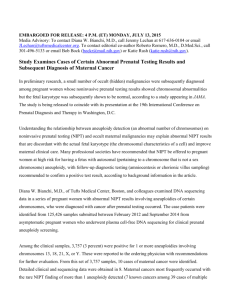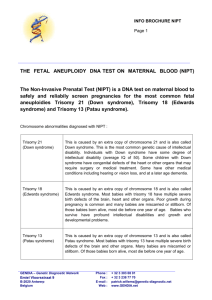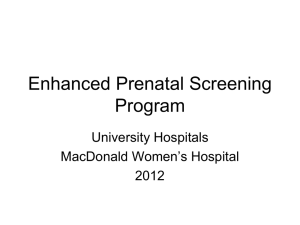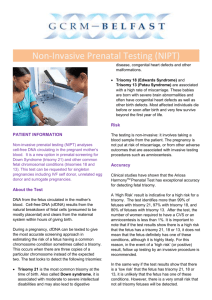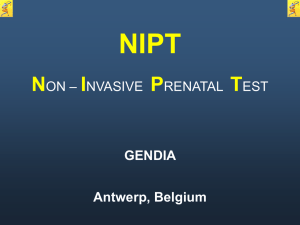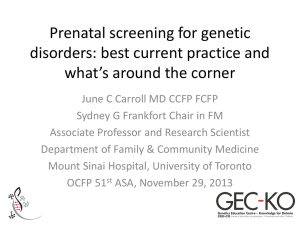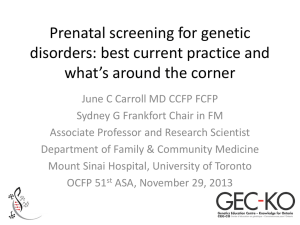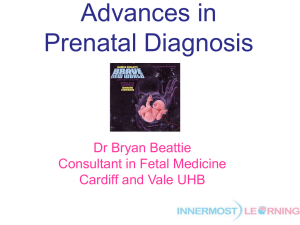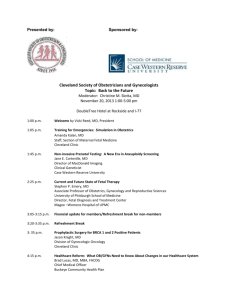Word Version Unratified Draft Protocol for Consultation
advertisement
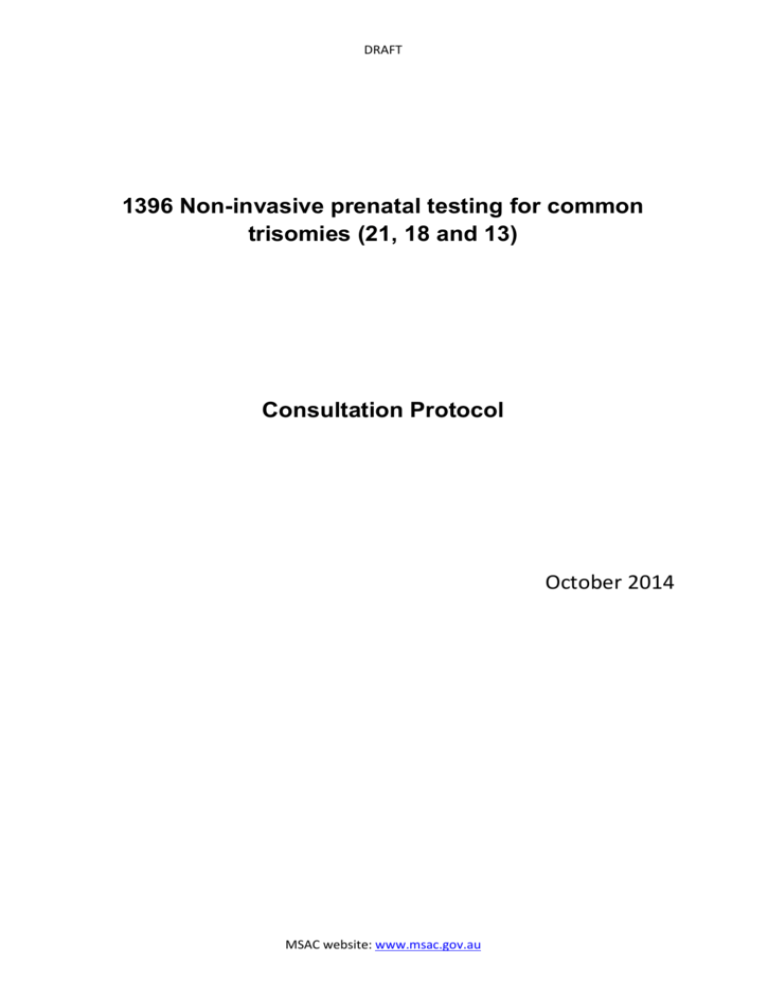
DRAFT 1396 Non-invasive prenatal testing for common trisomies (21, 18 and 13) Consultation Protocol October 2014 MSAC website: www.msac.gov.au DRAFT 1) Title of Application Non-invasive prenatal testing for common trisomies (21, 18 and 13) 2) Purpose of application Please indicate the rationale for the application and provide one abstract or systematic review that will provide background. Prenatal testing for fetal Down syndrome, which is caused by trisomy 21 (T21), and testing for other genetic conditions is the standard of care for the majority of the three hundred thousand women who give birth each year in Australia. Currently women undergo ‘combined first trimester screening’ (cFTS), which consists of ultrasound (including nuchal translucency) and maternal serum screening (serum BHCG and PaPP-A) performed at 11.5-13.5 weeks gestation. Women with a high-risk cFTS result (risk > 1/300) are considered to require additional testing with amniocentesis or chorionic villus sampling (CVS). Traditional prenatal screening tests for Down syndrome and other chromosomal conditions measure indirect markers and often require specialist referral for complex ultrasound evaluation. These traditional screening methods fail to identify up to 30% of Down syndrome cases and also have a 5% false positive rate. The detection rate for Down syndrome is 8595%, with a false positive rate of 5%, from cFTS and 70-75% at second trimester screening. This means 1 in 20 women, or 15,000 Australian women per year, receive a “false alarm”, which leads to maternal anxiety and unnecessary further testing with invasive procedures that can cause miscarriage. The risk of miscarriage with invasive amniocentesis is approximately 0.5% and up to 1% with CVS; therefore around 150 normal fetuses are lost in Australia each year due to unnecessary invasive diagnostic procedures. Non-invasive prenatal testing (NIPT) measures the cell-free fetal DNA (cffDNA) in the maternal plasma and uses the chromosome counts and fetal fraction to provide a risk assessment in the first trimester for trisomy 21, 18, and 13. Cell-free fetal DNA is generally thought to be derived mainly from the placenta, and is analysed by two general methods (massively parallel shotgun sequencing or targeted analysis) to identify the chromosome of origin of the cffDNA fragments. The relative proportion of DNA fragments originating from different chromosomes is then measured. If a fetus is trisomic then the proportion of DNA fragments related to that specific chromosome will be increased relative to other chromosomes. A high risk result (>1:100) is given when the number of fragments of an individual chromosome is present in more than the expected ratios compared to an internal or population reference. It should be noted that NIPTis a screening test, and high risk results require an invasive diagnostic test to confirm chromosomal abnormalities. NIPT has been shown in numerous clinical studies to identify more than 99% of Down syndrome cases at a false positive rate of less than 0.1% (Norton, 2012)In a recent large clinical study, NIPT improved the false positive rate and positive predictive value (PPV) by 90 fold and 20 fold, respectively, compared with first trimester combined screening (serum markers plus NT ultrasound), and demonstrated a sensitivity (detection rate) of 100% (see Section 3 of this protocol). NIPT thereby enables accurate identification of Down syndrome and other common trisomies without the MSAC website: www.msac.gov.au DRAFT need for invasive testing, the risk of miscarriage, and associated costs and distress to Australian families. Reference: Barlow-Stewart K, Emery J, Metcalf S, 2007, ‘Testing and Pregnancy (Ch 3)’, In: ‘Genetics in Family Medicine: The Australian Handbook for General Practitioners’, Biotechnology Australia, Canberra. 3) Population and medical condition eligible for the proposed medical services Provide a description of the medical condition (or disease) relevant to the service. NIPT is a genetic test for trisomies 21, 18 and 13, which together account for ~70% of all major chromosomal aneuploidies. All three trisomies are associated with physical and intellectual disability, and increased mortality. Down syndrome (T21) occurs when an extra chromosome 21 originates in the development of either the sperm or the egg. T21 is the most common clinically significant genetic condition in newborns, occurring in approximately 1 in 500 pregnancies (fetuses screened) and 1 in 700 newborns. Down syndrome is associated with delayed physical and intellectual development, and reduced life expectancy. People with Down syndrome are at a higher risk of infections, and around half of children with Down syndrome are born with a congenital heart defect. Edwards syndrome (Trisomy 18 [T18]) is due to an extra copy of chromosome 18, and is associated with a high rate of miscarriage. Infants born with Edwards syndrome may have various physical malformations, and their median lifespan is only 5-15 days. T18 occurs in approximately 1 in 5,000 newborns. Patau syndrome (Trisomy 13 [T13]), is due to an extra chromosome 13 and is also associated with a high rate of miscarriage. Babies born with Patau syndrome most commonly have nervous system complications, physical abnormalities and heart defects. More than 80% of children with Patau syndrome die within their first year of life. T13 occurs in approximately 1 in 16,000 newborns. Define the proposed patient population that would benefit from the use of this service. This could include issues such as patient characteristics and /or specific circumstances that patients would have to satisfy in order to access the service. The submission-based assessment (SBA) will evaluate NIPT in two proposed patient populations: 1. General pregnancy population, inclusive of all ages and risk category. 2. Higher-risk pregnancy population The MSAC department has provided advice that proposing two populations at the DAP stage is appropriate and that PASC may provide further advice as to which population group is the most appropriate. Since 2012, multiple clinical studies of more than 30,000 pregnant women have demonstrated the benefits of NIPT in the general pregnancy population. These studies have been accompanied by recent recommendations from professional societies and committees recognising the importance of providing NIPT to all pregnant women regardless of their age or risk of trisomy. For example: MSAC website: www.msac.gov.au DRAFT In March 2013, the American College of Medical Genetics (ACMG) issued a statement supporting NIPT in pregnant women without specifying any restrictions (Gregg et al 2013). In April 2013, the Blue Cross Blue Shield Association (2013) Technology Evaluation Center (TEC) determined NIPT for Down syndrome testing in “high” and “average” risk women meets their coverage criteria. In March 2014, both the UK Royal College of Obstetrics and Gynaecologists (RCOG 2014) Royal Australia and New Zealand College of Obstetrics and Gynaecologists (RANZCOG 2014) recognised the value of NIPT as a primary screen for all women. The RANZCOG (May 2014) communication on ‘DNA-based Non-Invasive Prenatal Testing for Fetal Aneuploidy’ states: “Data have recently emerged suggesting equal test performance of NIPT as a primary screening test for trisomy 21 in average risk women. The most appropriate implementation strategy for NIPT in the Australian context is still to be determined. Presently, combined first trimester screening with nuchal translucency measurement and serum markers remains an acceptable standard of care in high risk or average risk women. NIPT is an option for those women who are able to self-fund their testing, after appropriate pre-test genetic counselling.” Additional advice suggests that NIPT will lead to a demand in skilled genetic counselling, which at present is quite limited in its availability, especially in rural areas. Pre-test counselling will most likely be provided by the referring general practitioner (as a prolonged consultation) or midwife (there is no standard qualification required to provide this kind of counselling). Privately insured women may see a geneticist and would pay for the service. A positive result should be referred for post-test counselling with an expert. However, the increased demand for genetic counselling may only occur among women recommended NIPT due to a positive FTS result. In practice, NIPT would reduce the demand for preinvasive test counselling (due to the reduction in invasive testing), and may have no impact on counselling if funded for the general pregnancy population, where NIPT would be undertaken alongside or in lieu of current FTS. In particular, it is interesting to note that, although a maternal age ≥35 years at delivery is considered a high-risk factor for a trisomic pregnancy, many fetuses with Down syndrome are carried by women under the age of 35 years. It has been reported that 55% of estimated Down syndrome births occur in women under 35 years of age (CDPH 2009). For economic reasons, a higher-risk pregnancy population may be chosen as the eligible population for NIPT in the public health setting. Restricting the eligible population to women at higher risk of trisomies would reduce the total cost of NIPT, and maximise the benefit for that cost, but the test would be accessed by fewer women, create a disparity of care amongst arbitrarily defined pregnancy risk groups, and therefore detect fewer chromosomal abnormalities overall. All women who would currently be offered invasive diagnostic testing – either due to first trimester screening (FTS) results or other factors – should have the option to first utilise a highly accurate noninvasive test. For example, the American College of Obstetricians and Gynecologists (ACOG 2012) recommend the any one of the following high-risk indications for considering the use of cfDNA testing: Maternal age ≥35 years at delivery; Fetal ultrasonographic findings indicate an increased risk of aneuploidy; History of a prior pregnancy with a trisomy; MSAC website: www.msac.gov.au DRAFT Positive test result for aneuploidy, including first trimester, sequential or integrated screen, or a quadruple screen; Parental balanced Robertsonian translocation with increased risk of fetal T21 or T13. These criteria are similar to the current indications for invasive diagnostic testing in Australia (Barlow-Stewart et al 2007). The definition of a ‘positive’ test result for aneuploidy from first trimester, sequential, integrated or quadruple screening varies by provider. Several population studies recommend offering NIPT to women at ‘high’ or ‘intermediate’ risk. In the UK, King’s College Hospital and Medway Hospital are studying NIPT in all women with a FTS-based risk score >1:2500. In Australia, Hyett (2014) has proposed offering NIPT to all patients with a risk score from FTS greater than 1:1000 (albeit with women having a risk score >1:50 offered invasive testing). For the proposed higher risk patient population, NIPT would be offered to all patients with a combined first trimester risk of >1:2500. The accuracy of cfDNA testing in twins and in the low-risk population is available and has been validated with some of the NIPT technologies, but not all. Additionally, some but not all NIPT technologies are suitable for patients with donor egg or embryos, surrogates, and couples with close blood relationships. There is a test failure rate of up to 4%, and which increases as body mass index increases – fetal fraction of DNA is negatively correlated with maternal weight (the test failure rate is likely to be 50% at a maternal weight of 160 kg). Women with positive results on cfDNA screening test should be offered confirmation with diagnostic testing. In light of the above, the SBA will explore the costs, benefits and cost-effectiveness of NIPT in the general pregnancy and higher risk pregnancy populations, with the criteria for higher risk to be defined using local input and published data gathered as part of the assessment. Indicate if there is evidence for the population who would benefit from this service i.e. international evidence including inclusion / exclusion criteria. If appropriate provide a table summarising the population considered in the evidence. Non-invasive EXamination of Trisomy (NEXT) Study A pivotal prospective, multi-centre blinded cohort study has enrolled ~19,000 women and compared the use of Harmony NIPT as a first-line screening test to traditional FTS alone (PAPP-A, hCG, NT) for T21 risk assessment in all pregnant women, regardless of their age or risk status. This study, which was recently completed, is the largest, prospective, blinded study of NIPT conducted to date. In brief, women with a singleton fetus presenting in the first trimester for routine prenatal screening for fetal aneuploidy received both Harmony NIPT and FTS. FTS results were provided as part of routine care, and participants and care providers were blinded to the NIPT results (probability scores). Pregnancies were followed for newborn outcomes. Invasive test results or neonatal phenotype, with karyotype confirmation in cases of suspected aneuploidy, were used for T21 identification. NIPT, FTS results and outcomes were reported to an independent data coordinating centre. In total, 18,955 women were enrolled across 38 centres in the United States (US), Canada and Europe from March 2012 to April 2013 (mean maternal age 30.6 (range: 18-52) years, mean gestational age 12.4 (range: 10-14.3) weeks). Prevalence of trisomy 21 was 1 in 416, which is representative of a general pregnancy population that is seeking screening. The study was statistically powered for both sensitivity and specificity for T21, and its primary outcome was the MSAC website: www.msac.gov.au DRAFT area under the Receiver Operating Characteristic (ROC) curve for T21 test performance of Harmony and FTS. Study follow-up is complete. The preliminary results presented in Table 1 below have been presented at several international professional society meetings (e.g. Musci et al 2014) and the full study results (including the primary outcome) have been submitted for publication. Table 1 NEXT study preliminary results for T21 (Down syndrome)* Harmony First trimester combined screening Sensitivity (true positive rate) * False positive rate Positive predictive value 100% (38/38) 78% (30/38) 0.06% (9/15,803) 5.4% (854/15,803) 81% (38/47) 3.4% (30/884) * Invasive test results (amniocentesis or CVS) or neonatal phenotype (with karyotype confirmation in cases of suspected aneuploidy) were used for T21 identification. NEXT also collected information on identification of T18 and T13, which is currently unpublished and not reported here. The results above show all T21 cases to be detected with Harmony versus only 78% of cases with FTS. With Harmony, there is almost a 100-fold reduction in false positive test results and therefore a commensurate reduction in potential invasive procedures and resulting miscarriages downstream. The positive predictive value with Harmony was over 20 times higher than FTS. The NEXT Study also evaluated the accuracy of Harmony in detecting T18 and T13, and this information will be provided in the SBA. Further evidence for non-invasive prenatal testing and the identification of trisomies 18 and 13 is provided in the studies listed in Table 2 below. Additional studies Additional key evidence for the clinical performance of Harmony NIPT has (as of mid-2014) been documented in 12 additional published studies in general pregnancy or high-risk populations as summarised in Table 2 below. Table 2 Study Studies of Harmony NIPT clinical performance Sample (country) Primary outcomes (trisomies) General pregnancy population Musci 18,955 Area under the ROC 2014 (Can., curve Eur., US) (T21) Willems 3,000 Sensitivity, 2014 (Neth., specificity, FNR, FPR Belg.) Nicolaides 2,049 DR (sensitivity), FPR 2012 (UK) (risk cut-off 1%) (T21, T18) Ashoor 1,949 DR (sensitivity), FPR 2013 (2nd (UK, US) (risk cut-off 1%) stage) (T13) Study design Prospective cohort study. NIPT evaluated alongside FTS. Participant and physician blind to NIPT result. Clinical experience in Belgium & Netherlands Prospective cohort study. Blood collected at FTS. NIPT evaluated after invasive testing. Lab staff blind to trisomy status. Case control study. Blood collected at FTS (controls) or after invasive testing (cases). MSAC website: www.msac.gov.au DRAFT Sample (country) Primary outcomes (trisomies) Del Mar Gil 2013 1,005 (UK) FPR (risk cut-off 1%) (T21, T18, T13) Sparks 2012b 298 (US) Study Z-statistics (risk cutoff not reported) (T21, T18) Fairbroth 289 Negative and er 2013 (US) positive rates (risk cut-off not reported) (T21, T18, T13) Del Mar 275 DR (sensitivity), FPR Gil 2014 (UK) (risk cut-off 1%) (T21, T18, T13 in twins) Trisomy high-risk population Norton 3,228 Sensitivity, 2012 (Neth., specificity (by risk Swe., US) cut-off) (T21, T18) Verweij 520 Sensitivity, 2013 (Neth., specificity, FNR, Swe.) FPR, accuracy (risk cut-off 1%) (T21) Ashoor 400 Sensitivity, 2012 (Neth., specificity (risk cutSwe., US) off not reported) (T21, T18) Sparks 338 Sensitivity, 2012a (UK) specificity (by risk cut-off) (T21, T18) Nicolaides 177 DR (sensitivity), FPR 2014 (UK) (risk cut-off 1%) (SCA) Hooks 432 DR (sensitivity), FPR 2014 (UK) (risk cut-off not reported) (SCA) Study design Prospective cohort study. Blood collected at FTS. NIPT evaluated as per practice (prior to determining need for invasive test). Participant and physician unblinded to NIPT result. Case control study. Compared 'average-risk' women (no invasive testing at time of blood collection) with confirmed cases. Retrospective chart review comparing NIPT and FTS. Actual practice with NIPT implementation. Retrospective (NIPT evaluated after invasive test result, using blood collected at FTS) and prospective (NIPT as per actual practice). Prospective cohort study. Blood collected prior to invasive testing. NIPT evaluated after invasive test. Lab staff blind to invasive test result. Prospective consecutive cohort study. Blood collected prior to invasive testing. NIPT evaluated after invasive test. Lab staff blind to invasive test result. Nested case-control study. Blood collected prior to invasive testing. NIPT evaluated after invasive test. Lab staff blind to invasive test result. Each case matched to 3 controls for length of sample storage. Prospective study. Lab staff not blind (training set) or blind (validation set) to invasive test result. Case control study. Blood collected prior to invasive testing. NIPT evaluated after invasive test result. Lab staff blind to invasive test result. Case control study. Blood sample collected prior to invasive testing. NIPT evaluated after invasive test. Lab staff blind to invasive test result. It is anticipated the SBA will nominate NEXT as the pivotal study and primary source of clinical evidence for NIPT. However, a systematic search will be undertaken for the SBA to identify any other relevant studies that provide additional information and data on sensitivity and specificity of the test on T21, T18, and T13. The SBA will also seek to address any issues of the study data applicability to the proposed Australian population targeted for NIPT on the MBS. Provide details on the expected utilisation, if the service is to be publicly funded. The expected utilisation of NIPT if publicly funded for the general population can be estimated by multiplying the number of women at gestational age ≥10 weeks each year in Australia by expected uptake. A proxy is the number of mothers giving birth in Australia, which was 297,126 women in MSAC website: www.msac.gov.au DRAFT 2011, including live births and stillbirths (due to miscarriage or termination) from 20 weeks gestation (AIHW 2013). This number has been rising and is projected to be ~300,000 women at present. Current utilisation of prenatal screening for chromosomal conditions is estimated to be 60-80% in Australia, based on expert opinion. Assuming similar uptake of NIPT, suggests that up to 240,000 women would use the NIPT if funded for the general pregnancy population. This slightly underestimates the number of eligible women by the numbers who miscarry or elect to terminate during gestational weeks 10-19. In 2011, 166 women in South Australia underwent termination for fetal reasons (Scheil et al 2013). Assuming these terminations all occurred between gestational weeks 10-19 then, compared with 20,043 women giving birth in South Australia, the estimated degree of underestimation in expected utilisation is 0.083% (166 ÷ 20,043). Expected utilisation in a higher-risk pregnancy population requires the proportion of women meeting higher-risk criteria to be applied to the general pregnancy population. The ‘high risk’ population includes women aged ≥35 years, women identified as being at high risk based on FTS results, and women with a family history of chromosomal conditions. In 2011, 66,921 women aged ≥35 years gave birth in Australia (AIHW 2013). The number of women identified to be at high risk based on FTS is variable and depends on the risk cut-offs. Using the standard ‘increased risk’ cut-off of greater than 1:300 in a general pregnancy population estimates 15,000 women per year to be eligible for NIPT in Australia. This total (~80,000 women per year) underestimates the total eligible population, which would include other high-risk criteria. Expected utilisation in the high-risk population will be assessed in the SBA using published and commissioned (if required) data. Additionally, women identified to be at ‘intermediate risk’ based on FTS results may be included in the higher-risk pregnancy population. Estimating expected utilisation in this population requires low- and high-risk cut-offs to be specified, and data on the number of women falling within these cut-offs. Several studies have used a cut-off of 1:2500 or 1:1000 to define ‘intermediate risk’ for the purpose of offering NIPT. A detailed estimation will be undertaken in the SBA. 4) Intervention – proposed medical service Provide a description of the proposed medical service. The proposed MBS descriptor would be for NIPT that assesses the risk of fetal aneuploidies via cell free DNA analysis and measurement of fetal fraction (percent of cfDNA associated with the fetus) from maternal plasma. As fetal cfDNA represents a direct analyte of Down syndrome (trisomy 21) and other aneuploidies (trisomies 18 and 13), NIPT is a more accurate screening test for these trisomies than traditional screening tests such as ultrasound and maternal blood testing. All US based NIPT have been analytically validated as per the Clinical Laboratory Improvement Act (CLIA) and College of American Pathologists (CAP) regulatory requirements. If the service is for investigative purposes, describe the technical specification of the health technology and any reference or “evidentiary” standard that has been established. Harmony is one of several NIPTs using cfDNA to evaluate the risk of common trisomies. The Harmony test has been used internationally to guide care for over 300,000 pregnant women to date. Each NIPT uses a slightly different technology. The key technical specifications for Harmony NIPT are listed below. Assay – DANSR (Digital ANalysis of Selected Regions) MSAC website: www.msac.gov.au DRAFT o Chromosome selective approach: selectively evaluates specific genomic fragments from cfDNA o Determines fraction of fetal cfDNA in maternal plasma as well as the chromosome proportion by assaying polymorphic and non-polymorphic loci Risk algorithm – FORTE (Fetal-fraction Optimized Risk of Trisomy Evaluation) o Algorithm accounting for prior risk (based on maternal and gestational ages) and fetal fraction Tests for T21, T18 and T13. Includes the option to evaluate number of X and Y sex chromosomes and sex chromosome aneuploidies). This technology requires less DNA analysis than the Massively Parallel Shotgun Sequencing (MPSS) used by some other NIPT technologies and provides more DNA reads on the targeted chromosomes (21, 18, 13). The reference standards for the diagnosis of fetal trisomies are CVS and amniocentesis. Both of these invasive tests have a sensitivity and specificity 99% for the detection of common trisomies. The NEXT study comparing Harmony NIPT with FTS alone (see Section 3 of this protocol) used the results of these tests (or neonatal phenotype, with karyotype confirmation in cases of suspected aneuploidy) for T21 identification. Data from the NEXT study will be pivotal to the SBA of NIPT. Indicate whether the service includes a registered trademark with characteristics that distinguish it from any other similar health technology. Several private institutions offer an NIPT using cfDNA to analyse risks for common trisomies. However, each company uses a unique technology (Agarwal et al 2013). The Harmony test includes a registered trademark to differentiate from other NIPT technologies that have not been clinically validated in similarly large populations of pregnant women (the NEXT study enrolled ~19,000 women). In the US, the American Medical Association (AMA) chose to offer a unique reimbursement code (current procedural terminology [CPT] code) for the Harmony test: 81507 – Fetal aneuploidy (trisomy 21, 18, and 13) DNA sequence analysis of selected regions using maternal plasma, algorithm reported as a risk score for each trisomy. Indicate the proposed setting in which the proposed medical service will be delivered and include detail for each of the following as relevant: inpatient private hospital, inpatient public hospital, outpatient clinic, emergency department, consulting rooms, day surgery centre, residential aged care facility, patient’s home, laboratory. Where the proposed medical service will be provided in more than one setting, describe the rationale related to each. Currently, NIPT is commercially available in Australia via several-overseas based laboratories, however there is no Medicare funding or private health insurance rebate. A college communique from the Royal Australian and New Zealand College of Obstetricians and Gynaecologists in May 2014 estimated that over 2000 Australian women have opted to self-fund NIPT since its introduction in late 2012. NIPT is run in a laboratory (most currently based in the US). However, the maternal blood draw and consultation can occur in a number of settings including an outpatient office or pathology blood MSAC website: www.msac.gov.au DRAFT collection site, as described below. This is the same situation as for the blood samples collected for biochemical analysis as part of FTS. Describe how the service is delivered in the clinical setting. This could include details such as frequency of use (per year), duration of use, limitations or restrictions on the medical service or provider, referral arrangements, professional experience required (e.g.: qualifications, training, accreditation etc.), healthcare resources, access issues (e.g.: demographics, facilities, equipment, location etc.). NIPT can be delivered in the same clinical settings where FTS is currently delivered. In Australia, these settings include general practitioner offices, obstetric clinics, public or private hospitals, in vitro fertilisation (IVF) centres, ultrasound centres, and radiology centres. The test may be administered from 10 weeks gestational age through term. As a simple blood draw, no additional equipment, personnel or experience is necessary other than access to phlebotomy. A trained phlebotomist is required to draw maternal blood as routinely occurs for FTS currently. The test would be ordered by a physician, similar to current FTS tests. Two tubes (20mL) of maternal blood are collected for analysis. The blood is collected via a standard phlebotomy procedure and sent to a certified laboratory for analysis. All NIPT laboratories should only issue a report if the fetal cfDNA fraction is >4% of the total cfDNA in the sample received. Multiple studies have now verified the importance of fetal fraction and it is becoming recognized as an essential laboratory quality control metric. In 1-2% of cases a repeat sample is required due to low fetal fraction of cfDNA. Clinical studies demonstrate fetal fraction to vary positively with gestational age, negatively with maternal weight, and improve on blood redraw (Wang et al 2013), but to not vary by a priori trisomy risk classification (Brar et al 2013). 5) Co-dependent information (if not a co-dependent application go to Section 6) Please provide detail of the co-dependent nature of this service as applicable Not applicable 6) Comparator – clinical claim for the proposed medical service Please provide details of how the proposed service is expected to be used, for example is it to replace or substitute a current practice; in addition to, or to augment current practice. The comparator for NIPT in the general population of pregnant women at any risk is current FTS (i.e. biochemical and nuchal translucency screening without NIPT). The comparator for NIPT in the ‘higher risk’ population of pregnant women is CVS or amniocentesis. For the detection of trisomies 21, 18, or 13, NIPT can be used rather than biochemical and nuchal translucency screening, which are performed as part of the FTS. However, first trimester biochemistry is still required for PaPP-A levels to determine the risk of fetal loss, preterm birth, intrauterine growth restriction and pre-eclampsia. Ultrasound is still required for correct dating, diagnosis of multiple pregnancies, and chorionicity and anatomy assessment (fetal anomalies and physical deformities). This suggests that FTS, in particular NT screening, may continue to be performed alongside NIPT. These traditional screening tests have several limitations: MSAC website: www.msac.gov.au DRAFT Serum proteins and ultrasound use indirect and non-specific markers to assess trisomy risk. Measurements must be taken during specific time periods (first trimester bloods and NT between 11-13 weeks and second trimester bloods between 15-19 weeks). Ultrasound assessment typically requires referral to a specialist. Some screening protocols require measurements in both the first and second trimester, requiring multiple visits. These screening tests produce false positive rates of up to 5% for trisomies 21, 18 and 13 and fail to identify up to 30% of Down syndrome cases. Further, access to high-quality NT screening is variable across Australia. NT requires a skilled user to provide an accurate scan, and there is variation in the experience of operators. In some regional/rural areas, access is limited or not available. NIPT is therefore expected to substantially reduce the utilization of: MBS item number 66750 – first trimester biochemistry If a high quality NT scan is not readily accessible, it is anticipated that NIPT may be used, and there would therefore also be some reduction in the utilization of: MBS item number 55700 – nuchal translucency scan In addition, the use of NIPT is expected to reduce clinic visit numbers due to the need for multiple visits with FTS and/or referral to a specialist for invasive diagnostic testing. The introduction of NIPT is expected to impact the number of genetic counselling consultations required, including those paid for privately and those funded under the following MBS codes: Possible MBS codes for genetic counselling: MBS Item number 4001 – non-directive pregnancy support counselling services MBS Item numbers 81000, 81005, 81010 – pregnancy support counselling – eligible patients MBS Item number 16500 – antenatal attendance If NIPT is funded for a general pregnancy population (alongside FTS), the number of genetic counselling consultations is expected to decrease in line with the demand for invasive testing. Preand post-test counselling for NIPT is expected to be combined with FTS counselling. If NIPT is funded for a higher-risk population, there may be an increased demand for genetic counselling among women recommended NIPT due to a positive FTS result. However, this additional counselling visit may not be required and NIPT would reduce the demand for pre-invasive test counselling. The extent of the change in genetic counselling is therefore ambiguous and will be determined in the SBA. Due to its increased accuracy over FTS (as reported by the NEXT study – see Section 3 of this protocol), NIPT is expected to greatly reduce the numbers of subsequent invasive confirmation tests as only those who have a high risk NIPT result will require confirmation with invasive testing. The invasive tests are billed under the following MBS item codes: MBS item number 16600 – amniocentesis MBS item number 16603 – chorionic villus sampling MBS item number 104 – consultation MSAC website: www.msac.gov.au DRAFT MBS item number 73287 – karyotyping (cytogenetics) Invasive diagnostic tests are typically offered to women who receive positive first trimester screening results (including false positives) and to women with other high-risk criteria (age ≥35 years, previous pregnancy with trisomy, etc) who are collectively referred to as ‘high-risk’ pregnancies. Typically, a woman undergoes diagnostic testing by either amniocentesis or CVS, but not both tests. While these tests provide a confirmatory diagnosis, they are highly invasive and associated with a miscarriage risk of up to 0.5% with amniocentesis and up to 1% with CVS, with the case-specific risk being partly operator-dependent. This is additional to the background risk of miscarriage, which approximately ranges from 2-5% between gestational weeks 11 and 14 (Avalos et al 2012).The potential benefits of NIPT in lowering the risk of miscarriage and healthcare costs by avoiding unnecessary invasive testing are outlined in Sections 7 and 12 of this protocol. 7) Expected health outcomes relating to the medical service Identify the expected patient-relevant health outcomes if the service is recommended for public funding, including primary effectiveness (improvement in function, relief of pain) and secondary effectiveness (length of hospital stays, time to return to daily activities). NIPT is expected to reduce the number of invasive diagnostic tests and subsequently reduce the number of unintended fetal losses, including normal (euploid) fetuses, among pregnant women in Australia. The primary effectiveness outcomes proposed for the SBA are: trisomy (T21, T18 and T13) cases detected invasive procedures avoided ‘Trisomy cases detected’ is consistent with the primary outcome of the pivotal NEXT study – area under the ROC curve, which comprises information on sensitivity (detection rate) and specificity. Secondary effectiveness outcomes include the consequences of identifying trisomies and avoiding invasive procedures, including: trisomy (T21, T18 and T13) live births prevented euploid fetal losses (miscarriages of healthy foetuses) prevented These outcomes are further expected to improve overall quality of life for the pregnant population, by reducing the number of false positive results and associated anxiety for pregnant women, and reducing the need for invasive testing and associated discomfort and impact of related fetal losses. Additionally, improved detection of common trisomies will reduce the associated costs of lifetime care for children born with a trisomy. These consequences will be considered for inclusion in the economic evaluation to be undertaken for the SBA (see below). Describe any potential risks to the patient. NIPT provides an analysis of maternal venous blood collected using a standard phlebotomy procedure. Therefore, there are no potential risks to the mother from the technology, other than the minor side effects of bruising and inflammation (phlebitis) associated with a standard blood draw. There are no risks to the fetus from the procedure. Specify the type of economic evaluation. MSAC website: www.msac.gov.au DRAFT Cost-effectiveness analysis (CEA) will be used to evaluate NIPT relative to FTS for each of the two pregnancy populations outlined in Section 3 of this protocol (general pregnancy and higher risk). For each population, the CEA will compare total health care system costs and outcomes under two scenarios: 1. NIPT funded via the MBS (proposed practice). 2. NIPT not funded via the MBS, i.e. FTS only (current practice). The modelling approach will be consistent with recently published CEAs of NIPT (e.g., O’Leary et al 2013, Ohno and Caughey 2013, Song et al 2013). Total costs will include the costs of prenatal testing (NIPT, FTS, and invasive testing), elective termination (for identified trisomy cases where the mother chooses termination) and management of Down syndrome (for unidentified T21 cases). Management costs for infants born with Edwards or Patau syndrome will also be included, if reliable data are available. The model will account for the costs and consequences of false-positive and falsenegative results for T21, T18 and T13. Outcomes included in the economic evaluation will include the primary and secondary effectiveness outcomes above. 1. Trisomy cases detected 2. Invasive procedures avoided (CSV and amniocentesis) 3. Euploid fetal losses (miscarriages of healthy fetuses) prevented Published CEAs have tended to report cost-effectiveness as the cost per trisomy case detected. The CEA in the SBA will use this measure of cost-effectiveness and will also report the cost per nontrisomy (euploid) fetus saved. If NIPT is found to be cost saving, the net saving relative to current practice will be reported. Very few published CEAs of pregnancy testing have used quality-adjusted life years (QALYs) as an outcome. It is not intended to undertake a cost-utility analysis (CUA) in the SBA, due to the methodological issues in reliably estimating quality of life (utility) weights for Australian women experiencing a procedure-related loss, elective termination, and Down syndrome live birth. The time horizon for the CEA will be set to one year and the analysis will be undertaken for the number of pregnant women undergoing first trimester screening in a typical year. 8) Fee for the proposed medical service Explain the type of funding proposed for this service. NIPT would constitute a new and unique MBS service with an associated fee. Please indicate the direct cost of any equipment or resources that are used with the service relevant to this application, as appropriate. NIPT analyses a maternal blood sample drawn by standard phlebotomy. No unique equipment or resources are required for NIPT relative to current first trimester screening. Provide details of the proposed fee. The appropriate fee will be determined as part of the SBA. For reference, NIPT is currently offered in Australia privately at a cost of A$495-800. 9) Clinical Management Algorithm - clinical place for the proposed intervention MSAC website: www.msac.gov.au DRAFT Provide a clinical management algorithm (e.g.: flowchart) explaining the current approach (see (6) Comparator section) to management and any downstream services (aftercare) of the eligible population/s in the absence of public funding for the service proposed preferably with reference to existing clinical practice guidelines. The approach to first trimester prenatal screening for T21 and T18 recommended by RANZCOG (2010) is presented below. The same approach is also used to screen for T13 and other chromosomal abnormalities. Pregnant women are offered a risk assessment based on their age, biochemical blood analysis, and an ultrasound. Women with a risk of at least 1 in 300 for T21 (Down syndrome) are offered diagnostic testing via either CVS or amniocentesis. Women confirmed as carrying a trisomic fetus are offered the option of terminating their pregnancy. Figure 1 Current pathway for first trimester prenatal screening Pre-test counselling and information First trimester combined screening Risk assessed at 11weeks - 13 weeks 6 days) based on: 1. Maternal age. 2. Blood collected at 9 weeks – 13 weeks 6 days for biochemical analysis of: Pregnancy Associated Placental Protein-A (PAPP-A) Free βhCG 3. Ultrasound measurement of fetal nuchal translucency (NT), where available Not at increased risk (<1:300) ‘Increased risk’ (≥1:300) No further testing Pre-test counselling and information Diagnostic testing Chorionic Villus Sampling (CVS), OR Amniocentesis Source: Adapted from RANZCOG (2010) Provide a clinical management algorithm (e.g.: flowchart) explaining the expected management and any downstream services (aftercare) of the eligible population/s if public funding is recommended for the service proposed. If NIPT is publicly funded for all pregnant women it is expected to replace blood serum tests currently performed as part of FTS, due to its superior diagnostic performance in detecting common trisomies. There are currently no Australian clinical guidelines that define the place of NIPT. The RANZCOG (May 2014) suggest that ‘the most appropriate implementation strategy for NIPT in the Australian context is yet to be determined’ (RANZCOG, May 2014), but has acknowledged there is evidence supporting NIPT as a primary screening test. The American College of Obstetrics and MSAC website: www.msac.gov.au DRAFT Gynaecology suggested in an opinion statement in 2012 that maternal plasma testing should not be offered to ‘low-risk’ women, but used in ‘some form of contingent approach to higher-risk pregnancies’; in 2013 Canada recommended the maternal plasma testing ‘should be an option available to women at increased risk’. It is expected that most women would continue to receive an NT ultrasound to identify any fetal physical abnormalities (see Figure 2 below). Women indicated by NIPT to be at higher risk would be offered invasive testing. If NIPT is publicly funded for higher-risk pregnancies only, it is expected to be offered prior to diagnostic testing with CVS or amniocentesis, in order to avoid these invasive procedures and the associated risk of miscarriage, whilst providing a similarly and highly accurate diagnosis of T21, T18 or T13. The criteria for higher-risk pregnancies will be confirmed as part of the SBA but are proposed to be consistent with the ACOG 2012 criteria above (including maternal age ≥35 years and prior history of a trisomy birth) and/or a FTS risk score >1:2500. Women considered to be at high-risk based on NIPT results (>1:100) would then be offered invasive confirmatory testing (see Figure 3 below). Fewer women would therefore undergo invasive testing. Any decrease in the diagnosis of other chromosomal abnormalities is expected to be negligible, due to their low prevalence, and not pivotal to the assessment of NIPT since current FTS is targeted towards detecting the most common trisomies T21, T18 and T13. The potential place for NIPT in the clinical management algorithms are denoted in bold text in Figures 2 and 3 below. Figure 2 Expected pathway with NIPT funded for a general pregnancy population Pre-test counselling and information Risk assessed at 10+ weeks based on: 1. Maternal age 2. Blood collected at 9 weeks – 13 weeks 6 days for biochemical analysis of: Pregnancy Associated Placental Protein-A (PAPP-A) Free βhCG 3. Ultrasound measurement of fetal nuchal translucency (NT), where available 4. Non-invasive prenatal testing (NIPT) Low risk (<1:100 based on NIPT) High risk (≥1:100 based on NIPT) No further testing Pre-test counselling and information Diagnostic testing Chorionic Villus Sampling (CVS), OR Amniocentesis MSAC website: www.msac.gov.au DRAFT Figure 3 Expected pathway with NIPT funded for a higher-risk population Pre-test counselling and information Risk assessed at 10+ weeks based on: 1. Maternal age 2. Blood collected at 9 weeks – 13 weeks 6 days for biochemical analysis of: Pregnancy Associated Placental Protein-A (PAPP-A) Free βhCG 3. Ultrasound measurement of fetal nuchal translucency (NT), where available ‘Higher risk’ based on FTS (≥1:2500) and/or other factors Lower risk based on FTS (<1:2500) and/or other factors Pre-test counselling and information Low risk (<1:100) Non-invasive prenatal test High risk (>1:100) No further testing Pre-test counselling and information Diagnostic testing Chorionic Villus Sampling (CVS), OR Amniocentesis Note: ‘Higher risk’ criteria to be defined in submission-based assessment 10) Regulatory Information Please provide details of the regulatory status. Noting that regulatory listing must be finalised before MSAC consideration. NIPT is a Class 3 In Vitro Diagnostic (IVD), which is manufactured outside Australia. Presently, maternal blood samples are sent from Australia to the United States for analysis using NIPT and the results are communicated back to the Australian health care provider. NIPT is not currently included on the Australian Register of Therapeutic Goods (ARTG). Ariosa is currently in the process of applying for TGA approval of the blood tubes used to collect samples, and intends to eventually have the Harmony test performed locally in Australia. MSAC website: www.msac.gov.au DRAFT 11) Decision analytic Provide a summary of the PICO as well as the health care resource of the comparison/s that will be assessed, define the research questions and inform the analysis of evidence for consideration by MSAC (as outlined in Table 1). The key research questions to be addressed in the SBA are: 1. In pregnant women, how effective is NIPT relative to current first trimester screening practice for detecting trisomies 21, 18 and 13? 2. In pregnant women, how cost-effective is NIPT relative to current first trimester screening practice for detecting trisomies 21, 18 and 13? The SBA will address these research questions for two potential eligible populations: the general pregnancy population and a higher-risk population. The SBA will also compare the prevalence of trisomies and maternal characteristics between Australia and other countries (Canada, Europe, US) to demonstrate the applicability of the NEXT study and NIPT’s diagnostic performance to Australian practice. The PICO criteria are summarised in Table 3 below. Table 3 Summary of PICO criteria to define the research questions Patients Intervention Comparator 1) All pregnant women. 2) Pregnant women assessed by FTS and/or other factors to be at ‘higher risk’ of common trisomies. NIPT 1) General pregnancy population: maternal blood biochemistry (part of FTS) 2) Higher-risk pregnancy population: invasive testing (amniocentesis/CVS) 1) General pregnancy population: NIPTwould be performed at the FTS. 2) Higher risk population: NIPT would be performed prior to any invasive testing. Reference standard Amniocentesis or CVS Prior tests FTS – blood tests and NT Outcomes to be assessed Safety Miscarriages associated with amniocentesis/CVS Diagnostic accuracy Sensitivity Specificity Area under the ROC curve Positive predictive value Negative predictive value Change in management Effectiveness Trisomy cases detected Invasive procedures avoided (CVS and amniocentesis) Euploid fetal losses (miscarriages of healthy fetuses) prevented Cost-effectiveness Cost per trisomic fetus detected Cost per non-trisomy fetus saved. Costs of testing, counselling, miscarriage, termination and Down syndrome births (including false positives and false negatives. Questions 1. 2. In pregnant women, how effective is NIPT relative to current first trimester screening practice for detecting trisomies 21, 18 and 13? In pregnant women, how cost-effective is NIPT relative to current first trimester screening practice for detecting trisomies 21, 18 and 13? MSAC website: www.msac.gov.au DRAFT 12) Healthcare resources Using tables 2 and 3, provide a list of the health care resources whose utilisation is likely to be impacted should the proposed intervention be made available as requested whether the utilisation of the resource will be impacted due to differences in outcomes or due to availability of the proposed intervention itself. A list of healthcare resources likely to be impacted by the availability of NIPT is provided in Table 4. The cost-effectiveness of NIPT will not be determined using a state transition model – therefore, Table 3 of the draft protocol template has not been completed. 13) Questions for public funding Please list questions relating to the safety, effectiveness and cost-effectiveness of the service / intervention relevant to this application, for example: Which health / medical professionals provide the service Are there training and qualification requirements Are there accreditation requirements The key questions for public funding to be addressed in the SBA are listed below. Importantly, these questions will be addressed for each of two potential populations to be considered by MSAC for public funding of NIPT (general pregnancy and higher-risk pregnancy populations). It is anticipated that the funding decision will consider the relative outcomes, costs and cost-effectiveness of NIPTin each population. Clinical effectiveness If NIPT were offered in the first trimester: 1. What would be the increase in identification of T21, T18 and T13 fetuses? 2. How many invasive diagnostic procedures would be avoided each year? 3. How many miscarriages due to invasive procedures would be avoided per year? Cost-effectiveness If NIPT were offered in the first trimester: 1. What is the net total cost/saving to the Australian health care system per year? 2. What is the cost (if any) per additional aneuploidy detected? 3. What is the cost (if any) per euploid termination prevented? The costs of the other atypical chromosomal abnormalities that would have otherwise been diagnosed through amniocentesis or CVS will not be considered as they are only currently detected due to the high rate of invasive testing. They are not routinely tested or screened (and have a negligible prevalence) and are therefore less relevant to the submission. Furthermore, these abnormalities could be identified on ultrasound in the second trimester or if severe they would self-abort. Implementation 1. What is the most appropriate pregnancy population for MBS funding of NIPT? 2. What is the appropriate MBS fee for NIPT in the proposed population? 3. How would NIPT impact on current screening practice? i.e. to what extent, if any, would it replace the need for first trimester biochemistry and NT ultrasound? MSAC website: www.msac.gov.au DRAFT 4. If NIPT is implemented in a higher-risk population, what should be the risk cut-off(s) as assessed by FTS and other risk-based criteria for offering NIPT? References Agarwal A, Sayres LC, Cho MK, et al, 2013, ‘Commercial landscape of noninvasive prenatal testing in the United States’, Prenatal Diagnosis;33:521–531. American College of Obstetricians and Gynecologists (ACOG) Committee on Practice Bulletins, 2007, ‘ACOG Practice Bulletin No. 77: screening for fetal chromosomal abnormalities’, Obstetrics and Gynecology;109(1):217-227. American College of Obstetricians and Gynecologists (ACOG) Committee on Genetics, 2012, ‘Committee Opinion No. 545: noninvasive prenatal testing for fetal aneuploidy’, American College of Obstetricians and Gynecologists. Obstetrics and Gynecology; 120:1532-1534. Ashoor G, Syngelaki A, Wagner M, et al, 2012, ‘Chromosome-selective sequencing of maternal plasma cell-free DNA for first-trimester detection of trisomy 21 and trisomy 18’, American Journal of Obstetrics and Gynecology;206:322,e1–5. Ashoor G, Syngelaki A, Wang E, et al, 2013, ‘Trisomy 13 detection in the first trimester of pregnancy using a chromosome-selective cell-free DNA analysis method’, Ultrasound in Obstetrics and Gynecology;41:21–25. Avalos LA, Galindo C, Li D, 2012, ‘A systematic review to calculate background miscarriage rates using life table analysis’, Birth Defects Research (Part A);94:417-423. Barlow-Stewart K, Emery J, Metcalf S, 2007, ‘Testing and Pregnancy (Ch 3)’, In: ‘Genetics in Family Medicine: The Australian Handbook for General Practitioners’, Biotechnology Australia, Canberra. BlueCross BlueShield Association, 2013, ‘Sequencing-based tests to determine fetal down syndrome (trisomy 21) from maternal plasma DNA’, Technology Evaluation Center Assessment Program Executive Summary;27(10):1-6. Brar H, Wang E, Struble C, et al, 2013, ‘The fetal fraction of cell-free DNA in maternal plasma is not affected by a priori risk of fetal trisomy’, The Journal of Maternal-Fetal and Neonatal Medicine;26(2): 143–145. California Department of Public Health (CDPH), 2009, ‘Provider Handbook’, Richmond, California. Caramins M, Chopra M, 2014, ‘Non-invasive prenatal testing’, Common Sense Pathology; February 2014 MSAC website: www.msac.gov.au DRAFT Del Mar Gil M, Quezada MS, Bregant B, et al, 2014, ‘Cell-free DNA analysis for trisomy risk assessment in first-trimester twin pregnancies’, Fetal Diagnosis and Therapy;35(3):204-211. Del Mar Gil MM, Quezada MS, Bregant B, et al, 2013, ‘Implementation of maternal blood cell-free DNA testing in early screening for aneuploidies’, Ultrasound in Obstetrics and Gynecology; 42: 34–40. Fairbrother G, Johnson S, Musci TJ, Song K, 2013, ‘Clinical experience of noninvasive prenatal testing with cell-free DNA for fetal trisomies 21, 18, and 13, in a general screening population’, Prenatal Diagnosis;33:580–583. Geelhoed EA, Bebbington A, Bower C, et al, 2011, ‘Direct health care costs of children and adolescents with Down syndrome’, The Journal of Pediatrics;159(4):541-545. Gregg AR, Gross SJ, Best RG, et al, 2013, ‘ACMG statement on noninvasive prenatal screening for fetal aneuploidy’, Genetics in Medicine;15(5):395-398. Harris A, 2004, ‘The cost effectiveness of prenatal ultrasound screening for trisomy 21’, International Journal of Technology Assessment in Health Care;20(4):464-468. Hooks J, Wolfberg AJ, Wang ET, et al, 2014, ‘Non-invasive risk assessment of fetal sex chromosome aneuploidy through directed analysis and incorporation of fetal fraction’, Prenatal Diagnosis;34(5):496-499. Hyett J, 2014, ‘Non-invasive prenatal testing for Down syndrome’, Australian Prescriber, 37(2):51-55. Li Z, Zeki R, Hilder L, Sullivan EA, 2013, ‘Australia’s mothers and babies 2011’, Perinatal statistics series no. 28. Cat. no. PER 59, Australian Institute of Health and Welfare (AIHW) National Perinatal Epidemiology and Statistics Unit, Canberra. Musci T, Norton M, Brar H, et al, 2014, ‘Non-invasive EXamination of Trisomy (NEXT) Study: Directed cell-free DNA analysis versus 1st trimester combined screening for trisomy 21 risk assessment in a large routine pregnancy population’, Presented at the European Human Genetics Conference 2014, abstract P01.014-M, European Journal of Human Genetics;22(Suppl.1): 53. Nicolaides KH, Musci TJ, Struble CA, et al, 2013, ‘Assessment of fetal sex chromosome aneuploidy using directed cell-free DNA analysis’, Fetal Diagnosis and Therapy;35(1):1-6. Nicolaides KH, Syngelaki A, Ashoor G, et al, 2012, ‘Noninvasive prenatal testing for fetal trisomies in a routinely screened first-trimester population’, American Journal of Obstetrics and Gynecology;207:374,e1-6. Norton ME, Brar H, Weiss J, et al, 2012, ‘Non-Invasive Chromosomal Evaluation (NICE) Study: results of a multicenter prospective cohort study for detection of fetal trisomy 21 and trisomy 18’, American Journal of Obstetrics and Gynecology;207:137,e1-8. MSAC website: www.msac.gov.au DRAFT O’Leary P, Maxwell S, Murch A, Hendrie D, 2013, ‘Prenatal screening for Down syndrome in Australia: Costs and benefits of current and novel screening strategies’, Australian and New Zealand Journal of Obstetrics and Gynaecology;53:425–433. Ohno M and Caughey A, 2013, ‘The role of noninvasive prenatal testing as a diagnostic versus a screening tool – a cost-effectiveness analysis’, Prenatal Diagnosis;33:630–635. Royal Australian and New Zealand College of Obstetricians and Gynaecologists (RANZCOG), 2010, ‘College Statement C-Obs 4: Prenatal screening tests for trisomy 21 (Down syndrome), trisomy 18 (Edwards syndrome) and neural tube defects’, RANZCOG, East Melbourne. Royal Australian and New Zealand College of Obstetricians and Gynaecologists (RANZCOG), 2014, ‘College Communiqués: DNA-based noninvasive prenatal testing for fetal aneuploidy’, RANZCOG, East Melbourne. Royal College of Obstetricians and Gynaecologists (RCOG), 2014, ‘Non-invasive prenatal testing for chromosomal abnormality using maternal plasma DNA: Scientific Impact Paper No. 15’, RCOG, London. Scheil W, Scott J, Catcheside B, et al, 2013, ‘Pregnancy outcome in South Australia 2011’, Pregnancy Outcome Unit, SA Health, Government of South Australia, Adelaide. Song K, Musci TJ, Caughey AB, 2013, ‘Clinical utility and cost of non-invasive prenatal testing with cfDNA analysis in high-risk women based on a US population’, Journal of Maternal-Fetal and Neonatal Medicine;26(12):1180–1185. Sparks AB, Struble CA, Wang ET, et al, 2012, ‘Noninvasive prenatal detection and selective analysis of cell-free DNA obtained from maternal blood: evaluation for trisomy 21 and trisomy 18’, American Journal of Obstetrics and Gynecology;206:319,e1–9. Sparks AB, Wang ET, Struble CA, et al, 2012, ‘Selective analysis of cell-free DNA in maternal blood for evaluation of fetal trisomy’, Prenatal Diagnosis;32:3–9. Verweij EJ, Jacobsson B, van Scheltema PA, 2013, ‘European Non-Invasive Trisomy Evaluation (EU-NITE) study: a multicenter prospective cohort study for non-invasive fetal trisomy 21 testing’, Prenatal Diagnosis;33:996–1001. Wang E, Batey A, Struble C, et al, 2013, ‘Gestational age and maternal weight effects on fetal cell-free DNA in maternal plasma’, Prenatal Diagnosis,33:662– 666. Table 4 List of resources to be considered in the economic analysis Provider of resource Setting in which resource is provided Number of units of resource per Proportion of patients relevant time receiving resource horizon per patient receiving resource Disaggregated unit cost MBS Resources provided to identify eligible population MSAC website: www.msac.gov.au Safety nets* Other government budget Private health insurer Patient Total cost DRAFT Number of units of Disaggregated unit cost resource per Provider of Proportion of patients Other Private relevant time Safety resource receiving resource MBS government health Patient horizon per patient nets* budget insurer receiving resource First trimester Physician/ Antenatal 100% in the general 1 $39.75 NA combined screening – nurse clinic pregnancy population biochemistry (MBS model. item 66750) Less than 100% in the higher-risk pregnancy model: some women may be eligible for NIPT due to other reasons, e.g. prior history of fetal trisomy First trimester Ultrasound Antenatal 100%: would continue 1 $60.00 EMSN cap combined screening – operator clinic/imagine to be required to $32.95 nuchal translucency centre detect fetal (NT) scan deformities etc. (likely (MBS item 55700) to be lower in practice due to access issues) Resources provided to deliver proposed intervention NIPT Physician/ Antenatal 100% of eligible 1 TBD in SBA nurse clinic women (assuming full uptake) Genetic counselling Resources provided in association with proposed intervention – confirmatory testing for women testing positive for common trisomies Chorionic villus Obstetrician Hospital/clinic To be estimated from 1 (in practice, some $121.85 EMSN cap sampling (CVS) (MBS positive result rate of women may require $65.90 item 16603) NIPT, i.e. 100% of repeat testing for Amniocentesis (MBS Obstetrician Hospital/clinic women determined by various reasons) $63.50 EMSN cap NIPT to be at ‘highitem 16600) $32.95 risk’. In practice, Consultation (MBS Obstetrician Hospital/clinic $85.55 EMSN cap uptake will be item 104) $256.65 Karyotyping (MBS Obstetrician Hospital/clinic incomplete due to $394.55 miscarriage risks item 73287) Setting in which resource is provided MSAC website: www.msac.gov.au Total cost $39.75 $60.00 $121.85 $63.50 $85.55 $394.55 DRAFT Provider of resource Setting in which resource is provided Number of units of resource per Proportion of patients relevant time receiving resource horizon per patient receiving resource Disaggregated unit cost MBS Safety nets* Other government budget Resources provided to deliver comparator FTS, CVS, amniocentesis – see above Resources provided in association with comparator – confirmatory testing for women testing positive for common trisomies FTS, CVS, amniocentesis – see above Resources used to manage women with identified fetal trisomy Hospital admission Hospital Hospital To be estimated in for elective SBA based on positive termination result rate with NIPT, invasive testing uptake, and PPV of NIPT Resources used to manage unidentified fetal trisomy Management of Health care Health care All women giving birth Down syndrome system system to infants with T21 Management of MSAC website: www.msac.gov.au Private health insurer Patient Total cost To be verified in SBA. Cost has been estimated at $1,106 (Harris 2004) To be verified in SBA. Mean annual cost has been estimated at $4,209 (Geelhoed et al 2011) [Year 1 cost if one year horizon is chosen] DRAFT Provider of resource Setting in which resource is provided Number of units of resource per Proportion of patients relevant time receiving resource horizon per patient receiving resource Disaggregated unit cost MBS trisomies 18 and 13 in Year 1 for babies which survive. * Include costs relating to both the standard and extended safety net. EMSN = Extended Medicare Safety Net MSAC website: www.msac.gov.au Safety nets* Other government budget Private health insurer Patient Total cost
